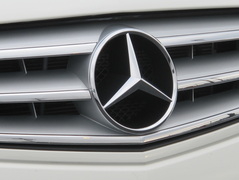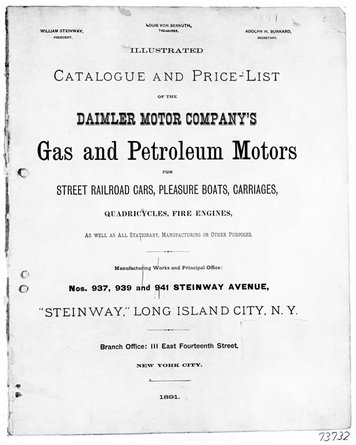 - Image © by Brian E. Faulkner -
- Image © by Brian E. Faulkner - While researching the origin of the current Mercedes-Benz tagline, I was reminded how close the car came to being called something else – at least here in America.
Were it not for a promising young man’s extended illness, Mercedes most likely would have been called by a name that had nothing to do with automobiles, a name known around the world by the time Gottlieb Daimler rolled out his high-speed internal combustion-powered automobile in 1886. Carl Benz developed his own car the same year, but the business entities that survived the inventors didn’t come together as Daimler-Benz AG until 1926.
In addition to automobiles, Daimler built engines for boats and industrial applications. That caught the eye of one William Steinway, of the famed piano family. He got in touch with Daimler, and on October 6, 1888, the Daimler Motor Company was organized in New York, where Steinway & Sons had already been in business for 35 years.
Steinway was convinced he could sell Daimler’s engines in the United States and acquired the rights to manufacture and market them for use in such things as cream separators, sewing machines, pumps, ventilating fans, printing presses and other applications that required a single-cylinder stationary engine.

“The cars which we intend to produce for the American market will be capable of carrying between two and four people and will be driven by engines with between 2½ and 3½ hp,” Steinway told a newspaper reporter in 1895. “Each car will have four different speed settings: 3½, 6, 9, and 14 miles per hour.”
However, this perspicacious man’s dream was not to be. He died at age 35 in November of the following year after a stubborn period of undiagnosed illness (probably tuberculosis). By that time he’d invested a frustrating amount of additional capital in the car company to offset continuing losses, so it’s likely he would have pulled out anyway. After William’s death, Daimler Motor Company’s holdings, including a factory built on Steinway’s land, was sold to newly organized Daimler Manufacturing Company, which in 1905 produced an “American Mercedes” based on the German model. This car was on the market for only eight years before its factory was destroyed by fire.
So had William Steinway lived and helped Daimler Motor Company overcome its ongoing financial problems, the American Mercedes just might have been called a Steinway ... which no doubt would have worked out fine, because both brands exemplify the best in their categories to this day.
Best is subjective, of course, but Steinway & Sons instruments are the pianos on which the overwhelming number of concert artists choose to perform – or aspire to perform, as they have almost since day one. William’s father, Heinrich Engelhard Steinweg, emigrated to New York from Germany during mid century, founded his business in a Manhattan loft, changed his name to Henry Steinway and set a quality standard that has endured through successive generations. His maxim was “Build the best piano possible. Sell it at the lowest price consistent with quality.”
And although the company has passed through a number of different owners since it was purchased from the Steinway family by CBS in 1972, Steinway & Sons remains at the top of the piano hierarchy and is the brand to which other fine pianos are most often compared. The company now is owned by American hedge fund manager John Paulson, a long-time admirer of its products. His stated goal is to assure Steinway & Sons’ "continuing greatness."
Henry and William clearly would have agreed on that.
Mercedes-Benz’ latest tagline also reflects the philosophy of its founder, as well as the quality bedrock on which the brand stands as it moves deeper into the 21st century.
You may recall the TV spot where Gottlieb Daimler nods off at his desk and dreams about the Mercedes-Benz of the future, with its now-familiar look, technology and style. As Daimler is awakened by a lovely assistant, we see a handwritten phrase scratched on the notepad beside him: The best or nothing -- underlined with a flourish. Though Mercedes-Benz has experienced some quality issues in recent years (not unlike Steinway), the brand is still held in high esteem, evidenced by frequent references to the “Mercedes of this” and the “Mercedes of that” as the marketers of other high-end product seek to compare their offerings to the car with the three pointed star.
“In the end, all any of us has is our good name,” a Mercedes print ad declared a while back. That’s true of Mercedes-Benz and true of Steinway & Sons. The two vaulted brands that nearly became kissin’ cousins a hundred-odd years ago have prospered -- and will continue to prosper -- in large part because of the quality foundation put in place by their founders.
TakeAway: Build your brand on bedrock quality and your reputation will follow, helping smooth the way over the inevitable bumps you encounter on your road to success.
Content © by Brian E. Faulkner

 RSS Feed
RSS Feed